You can Download Chapter 13 Organisms and Populations Questions and Answers, 2nd PUC Biology Question Bank with Answers, Karnataka State Board Solutions help you to revise complete Syllabus and score more marks in your examinations.
Karnataka 2nd PUC Biology Question Bank Chapter 13 Organisms and Populations
2nd PUC Biology Organisms and Populations NCERT Text Book Questions and Answers
Question 1.
How is diapause different from hibernation?
Answer:
| Diapause | Hibernation |
| (i) Dormant stage in development of an organism | (i) State of inactivity in a mature organism. |
| (ii) Occurs in summers and winters | (ii) Only during winters |
| (iii) Reduction in free water | (iii) No such adaptations |
Question 2.
If a marine fish is placed in a freshwater aquarium, will the fish be able to survive? Why or why not?
Answer:
It will not be able to survive for long because:-
- Water will enter the body by endosmosis
- As marine fishes drink lots of water, so excess water enters.
- It does not have salt absorbing mechanism as of freshwater fishes.
So, these fishes will die because of problem in osmolarity maintenance But due to hormonal mechanisms, migratory fishes are exceptions as they withstand the changes eg:- Hilsa, salmon
Question 3.
Define phenotypic adaptation. Give one example.
Answer:
Phenotypic adaptation:- It is non-genetic change in physical and physiological characteristics which develops in response to changes in environment and are useful to organisms in adjustment to prevailing Pvt. conditions.
eg:-
- Mountain sickness in normal people in high attitudes but tribes living in himalayas do not have mountain sickness
- Euphorbia hirta plant species.
![]()
Question 4.
Most living organisms cannot survive at temperature above 450C. How are some microbes able to live in habitats with temperatures exceeding 1000C?
Answer:
Temperature > 45°C causes precipitation of protoplasm and denaturation of enzymes. Therefore they die in most of organisms But some live in 1000°C (thermophiles) due to
- Branched-chain lipids that reduce fluidity of cell membranes.
- Inborn metabolism to produce heat-tolerant enzymes
- Reduced free water.
Question 5.
List the attributes that populations but not individuals possess.
Answer:
- Population density
- Birth rate
- Death rate
- Sex ratio
- Population growth
- Age distribution
- Population dispersal.
Question 6.
If a population growing exponentially double in size in 3 years, what is the intrinsic rate of increase (r) of the population?
Answer:

Question 7.
Name important defence mechanisms in plants against herbivory.
Answer:
Defence is of 2 types Morphological and chemical Defences.
Morphological defence –
- Thoms, spines, prickles, bristles
- Stinging hair, sticky hair, hairy coating
- Harbowing ants
- Resemblance to dreaded animals.
Chemical Defences
- Latex
- Alkaloids
- Tannins
- Silica
- Bitter taste, Offensive smell
- Irritating substance
- Poisonous cardiac glycosides.
Question 8.
An orchid plant is growing on the branch of mango tree. How do you describe this interaction between the orchid and the mango tree?
Answer:
Commensalism – orchid being space parasite benefitting from mango plant in obtaining space for residence but mango tree is not harmed.
Question 9.
What is the ecological principle behind the biological control method of managing with pest insects?
Answer:
The ecological principle behind control of pest insects is controlling growth of their population through natural enemies, predator, parasites.
![]()
Question 10.
Distinguish between the following:
(a) Hibernation and Aestivation
(b) Ectotherms and Endotherms
Answer:
| Hibernation | Aestivation |
| (i) Condition of passing the winter in a resting or dormant condition. | (i) State of inactivity during hot and dry summer. |
| (ii) Animal rests in warm place | (ii) Animal rests in cool, shady, moist place. |
| (iii) Lasts for whole winter. | (iii) Lasts for hot dry day because nights are often cooler |
(b)
| Ectotherms/Cold Blooded | Entotherms/Wann Blooded |
| (i) Unable to regulated their body temperature. | (i) Able to regulate their body temperature. |
| (ii) Lives in areas with favourable body temperature as they change their body temperature with respect to environmental temperature | (ii) Live in all places as there is only little effect on their body temperature by environmental temperature. |
| (iii) They show hibernation, aestivallon and are less active. | (iii) More active and no such inactive states are expressed |
Question 11.
Write a short note on
(a) Adaptations of desert plants and animals
Answer:
(a)
(1) Plants vegetation is sparse, grows during rains only. (Drought exoping)
(2) Annuals (Drought evaders)
(3) Succulents (Drought resisting) – stores water with mucilage and latex.
(4) Non succulent perennials (Drought enduring) – long roots and avoids transpiration by modification.
(5) Modifications
- leaves as spines and thorns
- Stems as water storage body with thick bark
- Long, deep roots with shoot system
Animals
- Lives in burrows
- Very little water requirement and can store water in modified body parts.
- Urine is concentrated and faeces is nearly solid with very little water and metabolic water is also used by them as source of water.
- Nasal counter- Current mechanism preventloss of water during breathing with small nostril size.
- Feeds on dry seeds and rehydrates and stores water when they reach a water body.
- Very small body surface are a so very less sweating so less water loss from body.
(b) Adaptations of plants to water scarcity
Answer:
same answer as above (drought/desert animals or plants).
(c) Behavioural adaptations in animals
Answer:
Snakes – in winter, the snakes will come out of their burrows and bask in the sun to warm their body for activity.
Desert lizards keep their body temperature fairly constant by their behaviour changes. When their body temperature drops below comfort zone, they would come out of burrow and bask in sun.
(d) Importance of light to plants
Answer:
In plants light influences photosynthesis growth and reproduction height influences flower induction, seed germination plant movement etc.
(e) Effect of temperature or water scarcity and the adaptations of animals.
Answer:
Animals living in arid areas are adapted to manage with scarcity of available water and reduce water loss to minimum.
Eg: Kangaroo rat feeds on dry seeds. Animals protect themselves from excessive cold by hibernation, thick for, constriction of peripheral blood vessel.
Question 12.
List the various abiotic environmental factors.
Answer:
- Atmospheric factors- Light, temperature, water, wind, humidity.
- Edaphic factors- Soil texture, soil water, soil air, soil pH soil micro organisms, minerals.
- Topographic factors – Slope, altitude, valley.
Question 13.
Give an example for:
(a) An endothermic animal
(b) An ectothermic animal
(c) An organism of benthic zone
Answer:
(a) An endothermic animal – Monkey (mammal)
(b) An endethsmml animal Frog (amphibian), snake (reptile)
(c) An organism of benthic zone – Angle Fish
Question 14.
Define population and community.
Answer:
Population Nearly/relatively permanent aggregation or grouping of interbreeding individuals of the same species present in a particular space or area at a given time who share the same gene pool.
Community (Biotic or Biological Community) Assemblage of different species present in the same area at the same time which show interactions and interdependence through trophic and spatial relationships.
Question 15.
Define the following terms and give one example for each:
(a) Commensalism
(b) Parasitism
(c) Camouflage
(d) Mutualism
(e) Interspecific competition
Answer:
(a) Commensalism:- Interaction where one species is benefitted and the other is neither benefitted nor harmed is called commensalism, eg: Clone Fish living in company of sea Anemones.
(b) Parasitism:- It is interspecific interaction in which small sized organism of one species obtains nourishment and spends a part or whole Of its life on or inside the body of large sized organism of other species, eg: Plasmodium in human, liver fluke in snail and fish.
(c) Camouflage:- Phenomenon of blending with surroundings with similar colour, marking, shape etc. to escape from predators and preys eg: Stick insect, leaf insect.
(d) Mutualism:- Interaction confers benefits on both the interacting species, eg: Lichen (fungus + Algae); Rhizobium and legumes.
(e) Interspecific competition :- struggle against, members of different species for obtaining some resource (food, water etc) eg: roots of plant species in same area of a forest
→ It is a potent force in organic evolution.
Question 16.
With the help of suitable diagram describe the logistic population growth curve.
Answer:
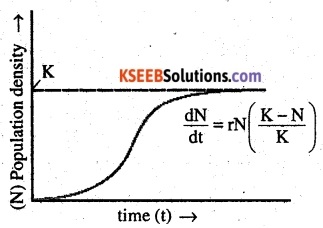
Logistic growth occurs because of natural selection. Here nature selects the filter (Survival of the fittest). Nature has resource to support maximum number of people (Carrying Capacity (K)) beyond which resources won’t support them due to their lock. This explain that log phase follows phase of acceleration. So we get sigmoid curve.
This growth is Verhulst-pearl Logistic Growth
\(D=\frac { dN }{ dt } =rN\left( \frac { K-N }{ K } \right) \)
N=Population density at time
K = Carrying capacity
r = Intrinsic rate of natural increase
Question 17.
Select the statement which explains best parasitism.
(a) One organism is benefited.
(b) Both the organisms are benefited.
(c) One organism is benefited, other is not affected.
(d) One organism is benefited, other is affected,
Answer:
(d) One organism is benefited, other is affected,
Question 18.
List any three important characteristics of a population and explain.
Answer:
Characteristics are: Population density, population growth, age distribution, birth rate, death rate, sex ratio etc.
(1) Population density:- Indicates size of population. It is number of individuals of a population found in a unit area or space at a given time. It is found out by total count
Random sampling.
\(D=\frac { N }{ S } \)
D – Population Density
N – total number of individuals of given area
S- unit of space or area
(2) Population growth:- It is increase in size of the population over a period of time.
Nt = No+ (natality +Immigration) – (Mortality +Emigration)
Nt= No +B + I-(D + E)
Nt = Population increase after time t;
No= Population at t = 0
(3) Age distribution :- Pre-reproductive, reproductive, post – reproductive.
it helps to provide information about the population – Expending, Declining or Stable population.
2nd PUC Biology Organisms and Populations Additional Questions and Answers
2nd PUC Biology Organisms and Populations One Mark Question
Question 1.
Define the term ecology.
Answer:
It is study of the relationships of living organisms with the biotic and abiotic components of the environment.
Question 2.
Name the factors essential for the formation ‘ of major biomes
Answer:
- The annual variation in the intensity and duration of temperature
- The annual variation in precipitation, account for the formation of major biomes.
Question 3.
Which one of the two stenothermals or eurythermals, shows wide range of distribution, on earth and why? (CBSE 2008)
Answer:
Eurythermals show a wide range of distribution as they can tolerate and thrive in a wide range of temperatures.
Question 4.
Between amphibians and birds, which will be stable to cope with global warming? (AI2008)
Answer:
Birds will be stable because they are eurythermals, which can tolerate wide range of temperatures.
![]()
Question 5.
Why many of the fresh water animals cannot live for long in sea water or vice versa. (Delhi 2008)
Answer:
This is because of the osmotic changes in the body.
Question 6.
Define homeostasis
Answer:
It is the self regulatory mechanism to maintain the internal environment constant despite changes in the external environment.
Question 7.
How do herbs and shrubs survive under the shadow of big canopied trees in the forest ? (AI 2008)
Answer:
They are adapted to photosynthesis optimally under very low light condition and hence survive under the shadow of big canopied trees.
Question 8.
Why is the polar region not a suitable habitat for tiny humming birds ? (AI 2008)
Answer:
The small birds have larger surface area to body volume ratio and tend to lose heat fast when it is cold outside; consequently they have to spend more energy to generate body heat.
Question 9.
Define the term migration
Answer:
Migration is the temporary, long-distance or short distance movements of animals from the stressful movement to a less stressful or comfortable environment and return to the original habitat when the stressful period is over.
Question 10.
Define the term hibernation.
Answer:
It is the process in which animals spend the winter in an inactive/dormant state,
eg: Frogs, polarbear.
Question 11.
When and why do some animals (frog, polarbear) go into hibernation (Delhi 2008)
Answer:
When the animals (like frog) are not able to migrate from unfavorable or stressful condition/habitat during very cold condition, they hibernate to avoid the stress by escaping in time.
Question 12.
Define the term aestivation?
Answer:
It is the process in which animals spend the dry, hot summer period in an inactive state,
eg: Snails.
Question 13.
When and why do some animals undergo into aestivation?
Answer:
When the snails are not able to migrate from stressful habitat in summers they undergo aestivation to avoid stress by escaping in time.
Question 14.
Define the term adaptation.
Answer:
The development of certain features in an organism in response to particular environment which may improve the chances of survivals are called adaptation.
Question 15.
What is Allen’s rule?
Answer:
Allen’s rule refers to the minimising of heat loss in animals by possessing shorter ears and limbs.
Question 16.
Why do people living in high altitude have a higher red blood cell count or total haemoglobin
Answer:
To compensate for the low atmospheric pressure and low oxygen content of air prevailing at high attitudes, people have higher, RBC count or total haemoglobin.
![]()
Question 17.
List any 2 physiological responses that help you to gradually get acclimatised to high attitudes when you go from the plains (Delhi 2008)
Answer:
- Increasing in breathing rate
- Decreasing in binding capacity of haemoglobin.
- Increase in RBC production.
Question 18.
Define Population density.
Answer:
The total number of individuals of a species present per unit area or volume at a given time.
Question 19.
Give an example where population estimation of an organism is done indirectly with out actually counting the organism. (AI2008)
Answer:
- The number of fish caught in a trap indicates the total population density in a lake
- The tiger census is based on the pug marks or faecal pellets.
Question 20.
When does a population growth curve become sigmoid?
Answer:
Sigmoid growth curve represents logistic growth where growth is slow initially and then becomes rapid the curve becomes steady due to resources become tending.
2nd PUC Biology Organisms and Populations Two Marks Questions
Question 1.
Why is thermoregulation more effectively achieved in larger animals than in smaller ones?
Answer:
Larger ones achieve thermoregulation more effectively than smaller ones because of less surface area/volume ratio in larger ones, hence lose body heat slowly.
Question 2.
Which one out of eurythermal or stenothermal species is likely to survive increased temperature?
Answer:
Eurythermal species as they can tolerate wide variations in environmental temperature; but stenothermal ones live with narrow range of temperature only.
Question 3.
Study 3 representative figure of age pyramids

(a). Mention names given to the 3 kinds of age profile (i), (ii), (iii).
Answer:
(i) Expanding population (Triangular)
(ii) Stable population (Bell shaped)
(iii) Declining population (Cube shaped)
(b). Which one of them is ideal for population and why?
Answer:
We take stable population pyramid as ideal because our aim is to stabilize the population.
(c). How do such age profile studies help policy makers get concerned about growing population?
Answer:
Age pyramid/profile can indicate
- Rate of growth of population
- Increase in elderly population and reproductive aged people.
These features help prepare for future planning on:
- Stress of family planning
- To help elderly and needful people to live comfortably.
Question 4.
(a) Write eg: for Verhulst Pearl logistic growth
Answer:
\(\frac { dN }{ dt } =rN\left( \frac { K-N }{ K } \right) \)
r=intrinsic rate of natural increase
N = Population density at time (t)
K = Carrying capacity.
![]()
(b) Draw graph for a population whose population density has reached the carrying capacity.
Answer:
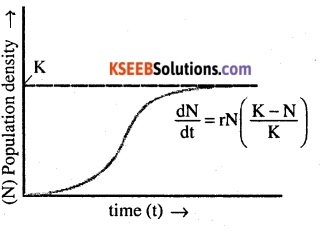
(c) Why is logistic growth model considered more realistic one for most animal populations?
Answer:
Logistic growth model is considered realistic in animals because each area has a carrying capacity beyond which environmental resistance grows and restrict their growth. It decreases natality and increases mortality.
(d) Draw growth curve where resources are not limiting growth of population?
Answer:
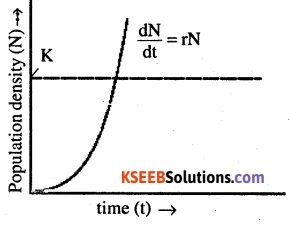
Question 5.
In adjacent population growth curves
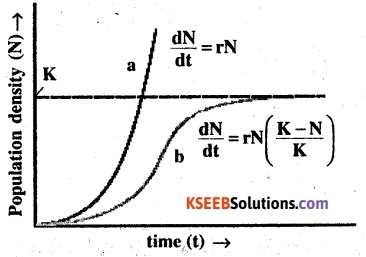
Answer:
Curve (a) – Non-limiting
curve (b) – Limiting and has reached carrying capacity.
(ii) In absence of predators which curve will be demonstrated?
Answer:
Curve (a) because of absence of controlling factor.
Question 6.
Mention any two significant roles predation plays in nature. (AI2008)
Answer:
- Predation is the natural way of energy transfer through trophic levels in a food chain.
- Predation keeps the prey population under control of ecosystem.
- Predation maintains spicies diversity.
Question 7.
List any two adaptive features evolved in parasites enabling them to live successfully on their hosts. (Delhi 2008)
Answer:
The adaptive features of parasites include
- Loss of unnecessary sense organs
- Presence of adhesive organs or suckers to cling on to the host.
- Loss of digestive system
- High reproductive capacity.
Question 8.
Name the four major biomes found in India.
Answer:
- Tropical rain forest
- Tropical deciduous forest
- Desert
- Seacoast
Question 9.
Write the influence of temperature in the life of organism.
Answer:
- The temperature affects the enzyme reaction in bur body.
- The thermal tolerance of organisms determines their geographical distribution.
Question 10.
Differentiate between Euryhaline and ‘ Stenohaline animals.
Answer:
Euryhaline animals Animals which can tolerate a wide range of salinity. Stenohaline animals Animals which can tolerate a narrow range of salinity.
Question 11.
What is the effect of light in the life of animals.
Answer:
- Intensity and duration of light influences the activities like foraging, migratory activities and reproduction.
- light influences the temperature and there by the metabolism of animals.
Question 12.
How do human being maintain constant body temperature?
Ans:
- In summer we sweat profusely; the evaporation of the sweat cools the body and brings the body temperature down.
- In winter, we shiver and that produces more ‘ heat, to raise the body temperature.
Question 13.
Mention 2 adaptations the mammals of colder region have, to minimize the loss of body heat.
Answer:
- Mammals of colder regions have shorter ears and limbs.
- Aquatic mammals of colder seas have thick layer of fat called blubber below the skin which acts as insulator reduces the loss of body heat.
Question 14.
Differentiate between Population size and Population Density.
Answer:
- Population size:- The number of individuals of a species, in a given area at a given time.
- Population density:- The number of individuals of a population per unit area at a given time.
Question 15.
Biomass is a more meaningful measure of population size. Explain.
Answer:
- If the population is huge, the total number is not as easily adaptable measure as counting takes a very long time or counting becomes practically impossible.
- For some ecological investigations, there is no need to know the absolute population size / density.
Question 16.
Define carrying capacity.
Answer:
Carrying capacity is the maximum number of individual of a population that can be sustained by a given habitat.
Question 17.
What is the role of predators in maintaining species diversity in an ecosystem?
Answer:
Predators help in maintaining species diversity in an ecosystem or community by reducing the intensity of competition among the competing prey species.
Question 18.
In what ways the prey species are adapted to escape from predators? Explain with example.
Answer:
- Some species of frogs and insects are cryptically coloured or camouflaged to avoid being detected easily by the predators.
- Some prey species are poisonous and are avoided by the predators.
Question 19.
(a) How is Cuscuta adapted to be a parasitic plant?
(b) Why do cattles avoid browsing on Calotropis plants? Explain. (CBSE foreign 2009)
Answer:
(a)
- Cuscuta has no chlorophyll and leaves.
- It develops haustoria to derive nutrition from the host it parasites.
(b) Calotropis plants possess a highly poisonous cardiac glycoside, which is fatal to animals.
Question 20.
Name two basic types of competition found amongst organisms. Which one of these is more intense and why?
Answer:
The two types of competitions are
- Interspecific competition and
- Intra specific competition
In this intra specific competition is more intense because it is an interaction among individuals of same species for similar requirements.
Question 21.
Explain interference competition with an example.
Answer:
In interference competition, even if the resource is abundant, the feeding efficiency of one species is reduced by the interfering and inhibitory presence of other species.
Eg: The Abingdon tortoise in Galapagos islands become extinct with in a decade due to the introduction of goat in that island.
![]()
Question 22.
Differentiate between commensalism and Amensatism.
Answer:
- Commensalism:- It is the interspecific interaction in which one species is benefited while the other is neither benefited nor affected.
- Amensatism:- It is an interspecific interaction in which one species is affected, while the other species is neither benefited or affected.
Question 23.
What is resource partitioning ? Give an example.
Answer:
It is the phenomenons in which two species competing for the same resource could avoid competition by choosing different patterns of foraging and different times of feeding. Eg:- Five closely related species of warblers living on the same tree have been shown to co exist and avoid competition by behavioural differences.
Question 24.
Give the interaction present in each.
(a) Cuckoo lays her eggs in the crow’s nest
(b) Orchid grows on a mango tree
(c) Cuscuta growing on a shoe flower plant
(d) Clown fish living among the tentacles of sea anemone
(e) Ticks live on the skin of dogs
(f) Mycorrhizae living on the roots of higher plants
(g) Sea anemone is often found in the shells of hermit crab (CBSE-Delhi 2008)
Answer:
(a) Brood parasitism
(b) Commensalism
(c) Commensalism
(d) Commensalism
(e) Parasitism
(f) Commensalism
(g) Commensalism.
Question 25.
Name and explain the interaction between fig trees and certain species of wasps.
Answer:
The interaction between fig trees and certain species of wasp is mutualism.
- The female wasp uses the ovary of flowers as a site of oviposition (egg laying) and the developing seeds as flood for the larvae.
- The flower is pollinated when the wasp is searching a place for oviposition.
Question 26.
What type of interaction is there between clown fish and sea anemone. Why?(AI 2008)
Answer:
The interaction between clown fish and sea anemone is commensalism. In this, one is benefitted and the other is neither benefitted nor harmed.
In this relation
(i) The sea anemone has stinging tentacles which keeps away the predators of clown fishes in this clown fish is getting benefit and the sea anemone is not getting any benefit or not harmed.
Question 27.
\(D=\frac { dN }{ dt } =rN\left( 1-\frac { N }{ K } \right) \)
(a) Which type of growth curve does it represents,
(b) What do the following notations represent
(i) \(\frac { dN }{ dt } \) (ii) r (iii) N (iv) K (CBSE 2005)
Answer:
(a) It represents logistic or Verhulst-Pearl logistic growth
(b) \(\frac { dN }{ dt } \) = rate of change in population size
r – intrinsic rate of natural increase
N – Number of ex histing individual
K – Carrying capacity.
Question 28.
Study the population growth curves shown in the diagam
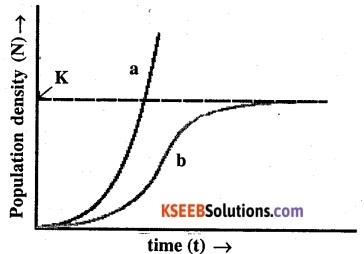
(1) Identify curves ‘a’ and ‘b’
(2) Mentions the conditions responsible for the curves ‘a’ and ‘b’ respectively
(3) Give the equation for the curve ‘b'(CBSE 2006)
Answer:
(1) a – Exponential curve
b – logistic or sigmoid curve
(2)
a – Unlimited food and other resources
b – Limited food and other resources
(3)
\(\frac { dN }{ dt } =rN\left( \frac { K-N }{ K } \right) \)
Question 29.
Study the table given below in regard to population interactions and the questions given below.

[(+) plus – beneficial interaction; (-) minus – detrimental interaction; 0 (zero) – neutral interaction.
(a) Identify the interactions a to e
(b) Explain each one. (CBSE 2008 comptt)
Answer:
A – B
(a) Amensalism – Species A harmed species B unaffected
(b) Predation/parasitism – Species A benefited species B harmed
(c) Competition – Species A and B mutually inhibited
(d) Mutualism – Both A and B benefitted
(e) Commensalism – Species A is benefitted Species B is unaffected.
Question 30.
Is the statement in correctly matched ? If it is incorrect, rewrite the correct form Camoflague : An organism showing resemblance with external environment animals or plants for the purpose of protection
Answer:
Incorrect:- Camoflague is blending with the back ground or surroundings due to similar colours, shape or marketing so as to remain unnoticed by predators (for protection) and prey (advantage).
2nd PUC Biology Organisms and Populations Three Marks Questions
Question 1.
What are Conformers? Why they haven’t evolved mechanisms for temperature regulation or osmoregulation.
Answer:
Conformers are those organism, which change their body temperature, osmolarity etc. according to the external ‘environmental conditions.
(1) During the course of evolution, the costs and benefits of maintaining a constant internal environment are taken into consideration, when it is not advantageous, the organisms have not evolved mechanisms to maintain homeastasis.
(2) Heat loss or gain is a function of surface area and hence very small animals are not found in polar region i.e. they have become distributed according to the external conditions.
(3) Similarly aquatic animals, that are conformers can change the osmolarity of their body fluid according to the surroundings.
![]()
Question 2.
How do organisms manage with stressful conditions existing in their habitats for short duration ? Explain with an example.
Answer:
Under such conditions
- The organisms move away from the stressful habitat to hospital area and returned to that area when it becomes normal state. eg: Siberian birds migrates to Bharatpur sanctuary in Rajasthan.
- The organisms under go hiberation if they can’t migrate
eg: Polarbear. - In higher plants seeds and some other vegetative reproductive structure serve as means to tide over stress conditions.
Question 3.
Explain different types of interspecific interactions
Answer:
(1) Beneficial interaction:-
- The interspecific interaction which is beneficial to both the species is called mutualism.
- Beneficial to one, but neutral to other.
- Commensalism
(2) Detrimental interaction:-
- Competition is the type of interaction that is detrimental to both the species.
- Parasitism- Beneficial to one and detrimental to the other.
- Amensatism – Detrimental to one and neutral to the other.
(3) Neutral interaction:- Commensalism is a type in which interaction is detrimental one and beneficial to the other.
Question 4.
Differentiate between ectoparasite and endoparasite.
Answer:
| Ecto parasit | Endo parasite |
| Those organisms which live on the surface of the other living organism and derive food from it eg: lice on human | Those organisms which live inside the body of other living organism and derive food from it eg: Plasmodium and liver fluke in man. |
Question 5.
What is brood parasitism? Give an example what adaptation has evolved in this phenomenon
Answer:
Brood parasitism is a phenomenon in which one species (parasite) lays eggs in the nest of other species (host) of bird and lets the host incubate them, eg: Cuckoo lays eggs in crow’s nest Cuckoo’s eggs shows resemblance with the eggs of crow in colour size etc which failed to identify by the crow with their eggs.
Question 6.
Name and explain the kind of interaction in the following
(1) Algae and fungi in lichens
(2) Head louse and humans
(3) Hermit crab and sea anemone.
Answer:
(1) Algae and fungi in lichens:-
- This is an example of mutualism in which both are benefited
- Fungi provide protection and helps in absorbing water and minerals where as the algae prepare food for the fungus.
(2) Head louse and human: This is an example of ectoparasitism the parasite gets shelter as well as food from human’s head.
(3) Hermit crab and sea anemone:- This is an example of commensalism in which sea anemone gets benefit for moving to places rich in nutrients while the hermit crab neither benefitted nor harmed.
Question 7.
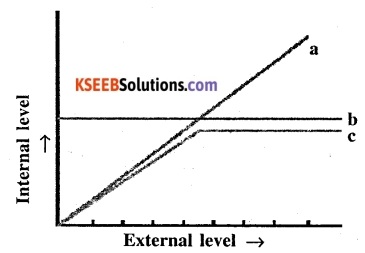
The above graph shows the organisms response to abiotic environmental factors. Name the categories of animals. Which show the pattern a, b, and c respectively and define each of them.
Answer:
(a) Conformers:
These are organisms which cannot maintain a constant internal environment but change the body temperature and osmolarity of their body fluids according to the external conditions.
(b) Regulators:
These organisms which maintain a relatively constant environment called homeostasis.
(c) Partial regulators:
These are organisms which have evolved the capacity to regulate the internal environment of the body to a limited range of external factors beyond which they become conformers.
Question 8.
Explain the following
(i) Predators are conducts of energy transfer
(ii) Predators are prudent in nature
Answer:
(i)
- A predator in a food chain feeds on the prey and obtains energy
- When the predator becomes a prey to another animal in the food chain, it transfers the energy obtained from ‘its’ prey.
(ii) If a predator is too efficient and overexploits the prey, the prey population becomes extinct. As a result predator will also become extinct due to the lack of food and hence predator are said to be prudent in nature.
![]()
Question 9.
The Mediterranean orched Ophrys employs a method called sexual deceit to get the flowers pollinated. Explain the phenomenon.
Answer:
In the flower of Ophrys, one petal resembles the female of a bee species in size, colour markings etc.
- The male bee perceives it as a female and pseudo copulates with it.
- During the process the pollengrains from the anthers become dusted on the body of bees. When this bee is attracted to another flower of this orchid species, the process is repeated and the pollengrains falls on the stigma hence pollination is achieved.
Question 10.
Mention any 4 adaptations seen is Xerophytic plants to cope up with water scarcity.
Answer:
- Xerophytes (Desert plants) have thick cuticle on their leaf surface.
- Leaves are absent or reduced to spines to prevent transpiration.
- Presence of sunken stomata to reduce water loss.
- The photo synthetic function is taken up by green flattened stems.